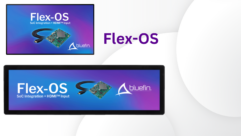
Tough Times at Retail? A Good Time for Digital Signage
Feb 12, 2008 8:00 AM,
By John W. DeWitt

Digital Signage Update recently interviewed Ken Goldberg, CEO of digital signage provider Real Digital Media, to discuss how the current economic downturn impacts the way retailers and implementers invest in and deploy digital signage networks. The keys to success, according to Goldberg: Clearly understand your payback, assemble a solid, cross-functional team, and pilot before you roll out new capabilities.
Digital Signage Update:What are the prospects for retailers’ investment in digital signage in 2008, given a disappointing 2007 holiday season and the current economic downturn?
Ken Goldberg: In the past, retailers have found tough environments to be a good time to make investments in technology. There are ways to conserve cash and head counts and other things while still investing to renew growth in the future. We have not seen projects go away since Christmas&em;if anything, they’ve increased. From our perspective, activity is at an all-time high across the board.
DSU:What can retailers and their implementation partners do to ensure the success of new digital signage networks in a tough retailing environment?
KG: To me, the real requirement for success in digital signage&em;whether you’re a retailer or the partner who is helping to implement it&em;is pulling together an ROI [return on investment] picture for projects. There are a few ways to accomplish this. One trend we’re seeing is a real participation from brands as sponsors or co-sponsors of networks. Maybe a brand wants to sponsor a network and get exclusivity for its category and this provides the investment backbone and an ROI story for the retailer. Another trend is more sophisticated measurement&em;tying in digital signage playout logs and with point-of-sale data to get an analysis of sales performance. You can compare your test/control stores&em;those with and without signage&em;as well as evaluate the uplift from different content.
DSU: There’s been a lot of talk about the convergence of kiosks and digital signage. Will this continue, and why?
KG: The convergence of digital signage and self-service applications is a major trend that plays into this ROI story. Real Digital Media is seeing that firsthand from our partnership with Source Technologies. We’re taking control of the idle time on kiosk platforms, and then passing control back to the self-service application when the customer interacts with it. In most self-service environments, there’s upwards of 75 percent idle time, which is typically taken up by an attractor loop. Now we have the ability to dynamically change that message, target it to different store locations, leverage current promotions in the newspaper or on TV, and get underwriting from sponsors. For instance, with the price-checker kiosk in the hardware aisle, a hardware supplier might want to sponsor content. There was a lot of discussion about this at the National Retail Federation show in January. I attribute the interest to the pretty clear ROI story relating to integration of digital signage and self-service because the ROI can be hard to calculate just for self-service applications alone.
DSU:As digital signage matures, what are the lessons retailers and signage providers should be drawing upon to ensure success?
KG: A big part of the story for resellers and retailers is understanding what the ROI is. That circles back to doing a pilot that lets you understand the impact of digital signage on your operations. We’re seeing a lot of testing of content strategies, rather than relying on just one strategy to implement a network. It’s a recognition that you have to walk before you run. A couple of years ago, people tended to assume that you could attract ads, generate sufficient response, and succeed. Now retailers are taking a much more measured approach to implementing and testing, and adding sophistication as they develop their ability to use the full capabilities of their digital network. Also, retailers are relying more on the expertise of a reseller or implementer to help structure a proper test, plan a proper rollout, and phase the implementation properly. People who are taking phased approach have a lot of success early, then can add sophisticated capabilities and content that builds on that early success.
A phased approach is crucial for advertising, as well.You’re not going to sell ads as fast as you think, because it ramps up just like everything else&em;your network size, your sophistication, your ability to measure, etc. So that ramp-up time is part of the investment in the success of a network. Rome and Wal-Mart weren’t built in a day. Take progressive steps, learn as an organization, and then build.
DSU:How does a digital signage rollout compare to introduction of other technologies?
KG: A lot of different retail functions participate in digital signage&em;marketing, merchandising, store operations, finance, and of course IT – so you have to be able to form a cross-functional team and understand the goals. There aren’t a lot of applications that cross those functions in the same way. Rolling out point-of-sale is far easier – it’s IT and store operations.
DSU:What’s on the horizon for digital signage technology at retail?
KG: Once we’ve figured out how to roll out digital signage and have a positive impact, how do we integrate it with other retail applications? That will be the next wave&em;for example, integrating with point-of-sale, merchandising, CRM [customer relationship management], and supply chain applications. Increasingly, retailers are using technologies for managing their portfolio of advertising and marketing assets, so you can market on the web, TV, radio, newspapers, etc.&em;and digital signage becomes another point of integration.
For more information, visit www.realdigitalmedia.com.










